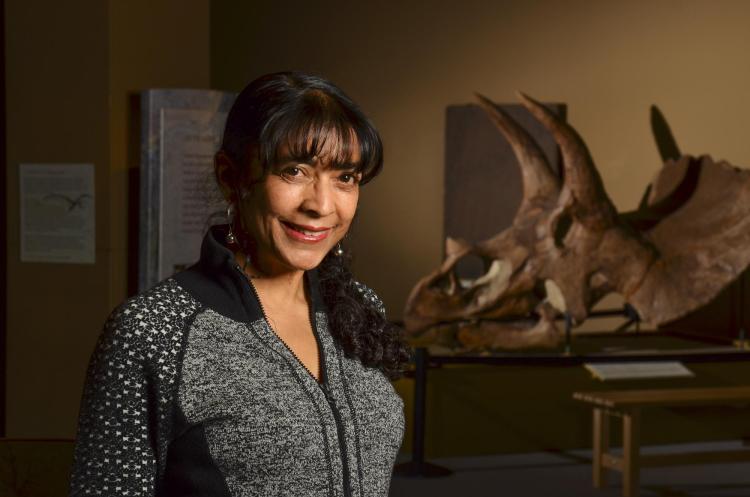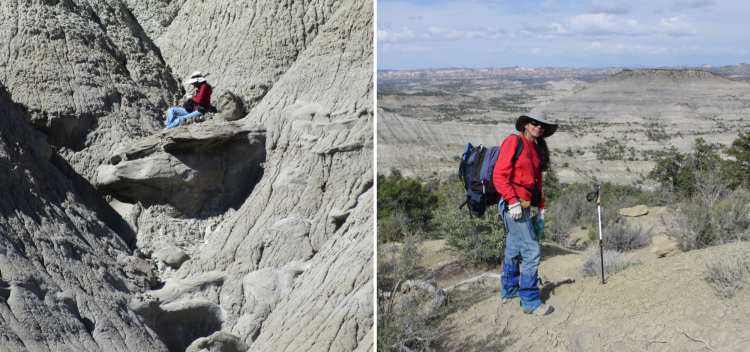Oh, poop! What looks like a rock is filled with clues
In studying dinosaur discards, CU Boulder scientist Karen Chin has gained expertise recently honored with the Bromery Award and detailed in a new children’s book
It was never Karen Chin’s plan to become the poop lady.
In fact, she started out as a naturalist, leading national park visitors on journeys of discovery via tiny, iridescent insect wings and soaring, ancient conifers, and everything in between.
“I wasn’t just interested in mammals or birds or plants; I was interested in how everything fit together, even the soil and the insects and the fungi and everything like that,” she says. “I realized that dung, it has such an ignominious reputation, but it really reflects the transfer of carbon resources throughout the ecosystem, which powers everything.
“Carbon resources are like money in the natural world—they’re how things are transferred back and forth. How carbon goes back into the ecosystem is very important, and dung provides a record of that. Fossil dung, which I study, provides a record of how that happened in the prehistoric world.”

Karen Chin, a University of Colorado Boulder professor of geological sciences and curator of paleontology in the CU Museum of Natural History, is a recognized authority on dinosaur diets and dung.
From her initial curiosity about ecosystems to finding clues in dung, Chin, a University of Colorado Boulder professor of geological sciences, has become a preeminent authority on dinosaur diets and the resulting dung that, some 75 million years later, is called a coprolite because it’s now fossilized.
In recognition of her contributions to science, not only was she recently recognized with the Geological Society of America’s Randolph W. “Bill” and Cecile T. Bromery Award for Minorities, but her story is featured in the newly published children’s book “The Clues Are in the Poo: The Story of Dinosaur Scientist Karen Chin.” The book recently was awarded the National Science Teaching Association's award for Outstanding Science Trade Books for Students K–12.
The book details her journey from being a child who loved nature but not dinosaurs, and who learned to love science from her father, to a researcher and educator who emphasizes that science is for everyone and open to all.
“I was very lucky because my father was a scientist, so I, myself, never doubted that I could be one, too,” she explains. “I could watch him and see that he did well. When you’re a child, you’re not thinking of discrimination so much, but now I know that he likely faced some. But growing up I thought, ‘My dad’s a scientist, so I can be one.’
“I realize how fortunate I was, because not everyone who has brown skin has a scientist in their family. So, for children who have aspirations to be a scientist and maybe don’t have scientist role models in their family, if they see me, a scientist of color, I hope that tells them it’s a possibility for them, too.”
Poop wasn’t the plan
But back to the poop: It was not the original plan.
Growing up in California, she was mesmerized by the natural world, memorizing the names of plants and insects and spending hours quietly watching the subtle changes in the life all around her. Her father, a former Tuskegee Airman, was a materials scientist who supported her love for science, even though women in science were few, and women of color even fewer.

"The Clues are in the Poo" children's book was created in collaboration between Karen Chin, author Jane Kurtz and illustrator Francisco Riolobos.
In college, she dreamed of working for the National Park Service and before graduating was hired as a seasonal interpretive ranger at Kings Canyon National Park in California. They had no official women’s uniforms when she received the job offer.
After working as a park interpreter for several summer seasons, she realized she wanted to get deeper into the science and accepted a job preparing dinosaur bones. One day, writing exhibit text for her boss, noted paleontologist Jack Horner, she learned that people had discovered fossil feces “and I thought that was the silliest thing,” Chin recalls. “How could soft material fossilize? I ran to Jack and said, ‘Did you know people say they found fossil dung?’
“Jack is kind of taciturn and he said, ‘Yep, and I found some, too.’ I asked, ‘Where? Where?’ He showed me what he thought was fossil dung, and studying those fossils turned into my doctoral dissertation. When I made a thin section of it—I ground it very, very thin so I could look at it through a light microscope—I could see plant cells from 75 million years ago that had gone through the dinosaur. That blew my mind, and I realized that this was a real window on dinosaur-plant interactions and the world they lived in.”
Studying coprolites is one of the more challenging areas of paleontology because unlike, say, vertebrate paleontology—in which scientists find a bone, it’s obviously a bone and they can tell you the dinosaur to which it belonged—coprolites look like rocks. Often, there’s nothing obviously indicating that it came out the back end of a dinosaur tens of millions of years ago, Chin says.
“First I have to say, ‘I suspect this is a coprolite’ and then offer the evidence for why I think it is,” she says. “Then I need to explain what it can tell us about the ancient world, even though I may not be able to tell you who produced the feces.
“I see coprolite study as high-risk, high-reward research because it’s challenging and you don’t know whether some avenues you explore will tell you that much. Because it is challenging, I think people have shied away from studying coprolites, but you can discover some really amazing things.”
Her research has included finding fossilized muscle tissue in a tyrannosaur coprolite (from an older relative of T. rex), a hugely exciting discovery, and revising what had previously been theorized about the diets of herbivorous dinosaurs. Studying coprolites revealed that at certain times of year some duck-billed dinosaurs ate wood, which doesn’t seem especially nutritious and Chin initially interpreted the woody content to be an inescapable consequence of eating conifers with tiny leaves.

Karen Chin works in the Kaiparowits Formation of southern Utah.
However, Chin realized that the wood tissues were different because they’d been rotted by fungus before the dinosaur ingested them, “so I needed to revise my interpretation,” Chin says. “Dinosaurs could have obtained cellulose from rotted wood, but if they were after cellulose, why not just eat leaves? Because we found these coprolites in the same horizon as nesting grounds, I hypothesized that when the dinosaurs were reproducing, they changed their diet to incorporate more protein. By feeding on rotted wood, which has lots of insects and crustaceans and snails hanging out in it, they were accessing a predictable source of protein.
“I don’t know if we’ll ever be able to definitively prove this hypothesis, but the discovery was really exciting and has changed our views of dinosaurs. For a long time, we thought of herbivorous dinosaurs as only eating leaves, but through the coprolites we know they sometimes ate rotted wood and ingested invertebrates.”
‘Everyone’s welcome in science’
Not only is Chin recognized for her expertise in coprolites, but for her rare gift of drawing even the most science agnostic into fascinating prehistoric tableaus to roam with dinosaurs. Plus, dinosaurs and poop?
“That’s the perfect marriage of two things kids find fascinating,” says Oregon-based children’s author Jane Kurtz, who wrote “The Clues Are in the Poo” in collaboration with Chin. “I remember thinking, ‘Wouldn’t it be fun to do something with dinosaur poo?’ Karen is quoted in a lot of other sources I’d been reading for a book I wrote about two early paleontologists who got in a bitter fight about identifying and naming Brontosaurus. So, just in that way that curious people do, and writers do, I was poking around and all roads seemed to lead to Karen.”
Kurtz emailed Chin about writing a children’s book based on her life, that would celebrate science and curiosity and be the book that Kurtz wishes she’d had as a girl who loved bugs and frogs and needed a science role model.
When Kurtz asked Chin how she felt about possibly publishing a picture book that would feature her, she was initially reticent to promote herself, but added that “’I know that young people of color really need to see themselves in this field’,” Kurtz recalls. “So, she addressed that straight on, and I thought, wow, perfect, she’s absolutely right, and we’re in a time of children’s books where people are being very careful to think about voices that have been left out.

Karen Chin working in southern Utah (left) and Montana.
“I told her that I felt I was left out of the science conversation as child, and I have a feeling there were lots and lots of people like me. I think everyone has the capacity to be fascinated by science. There are lots of books about dinosaurs, but there aren’t that many books that focus on how we know what we know about dinosaurs. To me, that’s the really intriguing question.”
That question also animates Chin’s passion for science and science education. She acknowledges that a lot of kids grow up loving dinosaurs and wanting to be paleontologists, which might explain why she often has English and physics and language majors in her upper-level paleobiology classes.
“I try to teach it so that everybody can get something out of it, but I also recognize that there are not that many jobs in paleontology and I think students realize that, too,” Chin says. “So, I tell the students that my goal is that if I run into you three years from now in Boulder and I ask you a very technical thing—for example, what kind of animal is a bryozoan?—I won’t expect you to remember some of those details. But I do hope you learned ‘how to learn’ and that you are committed to lifelong learning.
“I think one of the most important things I can teach is science literacy, so that when students see something—such as an article that makes a claim—they should be asking, ‘OK, where’ the evidence?’ and thinking about whether the article presents a reasonable conclusion. You don’t have to pursue a career in science to be a part of it. Everyone’s welcome in science.”
Did you enjoy this article? Subscribe to our newsletter. Passionate about geological sciences? Show your support.

